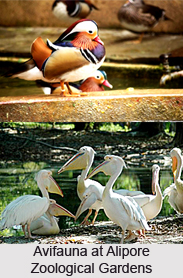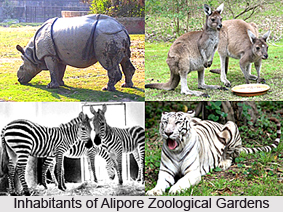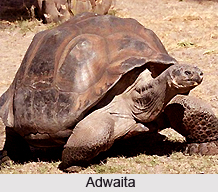 Alipore Zoological Gardens, situated in Kolkata city of the Indian state West Bengal, is known to be the oldest formally stated zoological park of India. Spanning over an area of 18.81 ha, it is open to public as a zoo since 1876. It serves as one of the major tourist attractions of the city. It is also recognized as the home to the Aldabra Giant Tortoise Adwaita, which was more than 250 years old but died in the year 2006. It also nurtures some captive breeding projects associated with the Manipur Brow-antlered Deer.
Alipore Zoological Gardens, situated in Kolkata city of the Indian state West Bengal, is known to be the oldest formally stated zoological park of India. Spanning over an area of 18.81 ha, it is open to public as a zoo since 1876. It serves as one of the major tourist attractions of the city. It is also recognized as the home to the Aldabra Giant Tortoise Adwaita, which was more than 250 years old but died in the year 2006. It also nurtures some captive breeding projects associated with the Manipur Brow-antlered Deer.
History of Alipore Zoological Gardens
History of Alipore Zoological Gardens dates back to 1800 when a private menagerie was established by the then Governor General of India. However the growing concept of zoos all around the world that time inspired them to upgrade it to a formal zoo and various initiatives led to the formation of Alipore Zoological Gardens. It was inaugurated by Edward VII, then Prince of Wales, in January 1876. Over years it underwent various developments. For that era, the zoo had exceptionally high scientific standards.
 Attractions of Alipore Zoological Gardens
Attractions of Alipore Zoological Gardens
Alipore Zoological Gardens has a vast number of faunal species which attracts a number of tourists. It shelters an Elephant House, a Primate House, a Reptile House and a Panther House which leads to the open air enclosures for Tigers and Lions. There is also a glass-walled enclosure for Tigers which is accredited to be the first of this kind in India. It also houses a separate children"s zoo. Numerous migratory birds get allured in the zoo by the central water bodies in the zoo grounds. The Calcutta Aquarium stands just across the street and has the affiliation from Alipore Zoological Gardens.
 Animals in Alipore Zoological Gardens
Animals in Alipore Zoological Gardens
A plethora of animals dwell in Alipore Zoological Gardens belonging to varied species. There are about 1266 individuals and around 108 species in the zoo. Mammals of the zoo comprise Red Kangaroo, Bonnet Macaque, Black Buck, Giant Squirrel, Sloth Bear, Himalayan Black Bear, Rhesus Macaque, Hog Deer, Reticulated Giraffe, Fallow Deer, Striped Hyena and others. Reptiles inhabiting the zoo include Chequered Keelback, Indian Cobra, Marsh Crocodile, Indian Starred Tortoise, Rhinoceros Iguana, Indian Python, Mugger, Saltwater Crocodile and many more. The zoo also shelters a number of avian species such as White Peafowl, Spoonbill, Green Imperial Pigeon, Sarus Crane, White-Capped Pionus, African Grey Parrot, Greater Sulphur Crested Cockatoo, Hill Myna, Quaker Parakeet, Domestic Goose, Emu, Painted Stork etc. Primates in the zoo constitute Olive Baboon, Hamadryas Baboon, Slow Loris, Slender Loris, Common Marmoset and Chimpanzee.
Adwaita
Aldabra Giant Tortoise Adwaita was the most prominent specimen of Alipore Zoological Gardens which was gifted to the zoo in 1875. It was brought from Seychelles by the British seafarers for Lord Clive"s menagerie. It was 250 years old when it died in the year 2006 and was a contender for the longest lived animal.
Breeding Programs at Alipore Zoological Gardens
Alipore Zoological Gardens was one of the first zoos of the world which bred White Tigers and the Common Reticulated Giraffe. Breeding of some megafauna has also been successfully done in the zoo however the breeding of rare species have not met much success. This often occurred due to lack of funding and initiatives. The breeding program of the Manipur Brow-antlered Deer, also called Thamin, at the Alipore Zoo has achieved great success and helped to bring back the species from the verge of extinction.
Adoption Scheme at Alipore Zoological Gardens
Alipore Zoological Gardens has launched a scheme called "Adopt an Animal" in August 2013 for obtaining funds. The people who adopt animals are given tax benefits and are also allowed to have their name placed on a plaque at the enclosure of the animal and can also use photos of the animals in promotional materials. The chairman of Confederation of Indian Industry (CII) National Committee on Exports, Sanjay Budhia, has adopted a One-Horned Rhino.
Ecological Importance of Alipore Zoological Gardens
Alipore Zoological Gardens serves as the home to wintering migratory birds. There is a sizable wetland inside the zoo. As the zoo is surrounded by urban settlements, the wetland forms the only resting place for many birds and is the focus of the conservationists in Kolkata. However over years, the number of migratory bird arriving at the zoo has declined owing to the increased pollution, declining quality of the water bodies, construction of high rises etc.



















